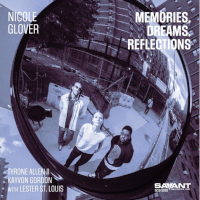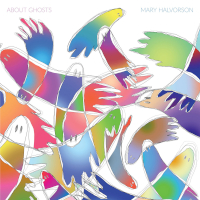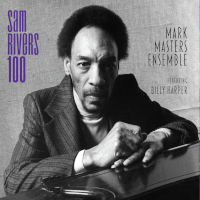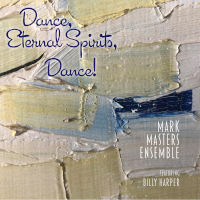Moment's Notice
Reviews of Recent Media
(continued)
Jorge Espinal
Bombos y cencerros
Buh Records BR196
 Bombos and cencerros are percussion instruments used in traditional Latin American folkloric dance music, used to set the pulse in parties, processions, and street celebrations. A Bombo is an Argentinian bass drums made from a hollowed-out tree trunk with heads made from animal skins. Cencerros are clapperless cowbells struck with sticks. That might seem an odd choice for the name of a solo album by Jorge Espinal, a Peruvian guitarist and improviser based in Argentina. But Espinal has extended his approach to his instrument, preparing and augmenting it to create a new sound world. He started out experimenting with preparations, using a variety of materials and techniques to abstract the sound of his guitar but has delved into more expansive methods.
Bombos and cencerros are percussion instruments used in traditional Latin American folkloric dance music, used to set the pulse in parties, processions, and street celebrations. A Bombo is an Argentinian bass drums made from a hollowed-out tree trunk with heads made from animal skins. Cencerros are clapperless cowbells struck with sticks. That might seem an odd choice for the name of a solo album by Jorge Espinal, a Peruvian guitarist and improviser based in Argentina. But Espinal has extended his approach to his instrument, preparing and augmenting it to create a new sound world. He started out experimenting with preparations, using a variety of materials and techniques to abstract the sound of his guitar but has delved into more expansive methods.
He explains, “In a way, I’ve never stopped thinking of the guitar as a sound device with infinite possibilities. These days I’m working with it in a different way. I still prepare it, but more lightly. I’m using metal sheets across the strings to get a percussive, harsh tone, but now I’m adding a kick drum pedal with my left foot, a cowbell with my right, plus a looper, freeze pedal, and MIDI foot controller. So now it’s about building a coherent and cohesive language with all those things happening at once. I think of it as an extended guitar, something that is not just a guitar anymore.” Across nine short studies, Espinal utilizes that setup for a dizzying explosion of textures, beats, samples, loops, and overlapping threads for improvisations that call on his interest in sound structure, and the micro-rhythms of Peruvian cumbia, Gnawa, and the expansive threads of the Latin American experimental music scene.
Things kick off with the percolating, off-kilter rhythmic cycles of “pan con chicharrón” which bumps and careens with interwoven sine waves, cyclically plucked guitar, sputtering percussion, and electronics, providing a brilliant introduction of what is to come. A piece like “trompo bien quiñado” is threaded through with percussive detail and insistent repetition interleaved with free guitar lines. The jump-cut cross rhythms of “azul, paredón, tanques de agua” threaten to veer out of control at any moment, but Espinal weaves it all together with deft flair. The detuned guitar lines of “tarascón” bound across fractured beats with entwined lines that move in and out of sync. Espinal has previously recorded in group setting including improvisations and readings of Cage scores with the group CALATO, as part of the noise duo Ricarda Cometa, and in a guitar/sax/drums lineup. Bombos y cencerros is an auspicious solo debut.
–Michael Rosenstein
Nicole Glover
Memories, Dreams, Reflections
Savant CD 2225
Rico Jones
Blood Lines
Giant Steps Arts GSA 17

 There has been a creative space in jazz between the mainstream and the avant-garde for well over a half-century. Don Heckman spoke to this in detail sixty years ago in his 1965 notes for Sam Rivers’ Contours, a text well worth rereading. Booker Ervin was hip to this when he named his most envelope-pushing album The In Between. The size and parameters of this in-between space has continuously morphed over time, in large measure because the mainstream keeps assimilating its methods and materials. The liability for younger artists occupying this space is that neither the mainstream audience nor the avant-garde audience may fully embrace them. Anyone who does not see the necessity for and the vitality of the in-between is the poorer for it.
There has been a creative space in jazz between the mainstream and the avant-garde for well over a half-century. Don Heckman spoke to this in detail sixty years ago in his 1965 notes for Sam Rivers’ Contours, a text well worth rereading. Booker Ervin was hip to this when he named his most envelope-pushing album The In Between. The size and parameters of this in-between space has continuously morphed over time, in large measure because the mainstream keeps assimilating its methods and materials. The liability for younger artists occupying this space is that neither the mainstream audience nor the avant-garde audience may fully embrace them. Anyone who does not see the necessity for and the vitality of the in-between is the poorer for it.
Nicole Glover and Rico Jones are two composing tenor saxophonists who revel in the in-between. They exemplify the criteria Heckman laid out: the development of a supplementary vocabulary of “sound devices” (now commonly called extended techniques), the avoidance of stock chord patterns, and the use of a rhythmic flexibility that moves the music back and forth from traditional swing to what was in the day called “pulse.” Their commitment to the trio format is also noteworthy, as it acknowledges a lineage stretching back to Sonny Rollins’ great units of the late 1950s. Glover’s Memories, Dreams, Reflections and Jones’ Blood Lines are timely reminders of the vital role the in-between plays in the current dynamic of headliners and outcats.
Glover well knows the world of the headliners from her work with Esperanza Spaulding, Artemus and Christian McBride, which makes her own albums all the more laudable for their tenacious avoidance of facile crowd-pleasing gestures. Her solos on Memories, Dreams, Reflections have something of a Joycean playfulness, as she compounds phonons and phrases from various dialects of the tenor tradition with remarkable sophistication. However, there is nothing gratuitous about it; whether Glover is turning an angular line inside out or she is dredging the contours of a ballad, there is a palpable sense of her using this fluency to drill down to the heart of the material. Throughout the proceedings, bassist Tyrone Allen II and drummer Kayvon Gordon frequently brave the in-between space, neither comping nor soloing, to the music’s benefit. Two thought-provoking tracks that add cellist Lester St. Louis are indicators that Glover continues to grow as a composer and bandleader, as well.
Jones has had his brushes with headliners, playing NYC’s Blue Note in Spaulding’s band earlier this year; however, Jones’ music fortunately lacks upscale pretensions. Recorded at Ornithology in Brooklyn, Blood Lines has all the ingredients for a durable club recording: ear-grabbing themes; plenty of solo space; and a quartet capable of raising the bandstand. Jones has distinctively absorbed post-Coltrane dialects and blends them into engaging, free-ranging extended solos. He has an excellent front-line foil in guitarist Max Light, who is simply blazing throughout, and he has turbo-charged propulsion with bassist Joe Martin and drummer Nasheet Waits. A good way to gauge who artists are trying to reach is how they lead off a set or album; launching into a 30-minute suite indicates Jone is going for a qualified audience, not tourists. It is a choice that puts Jones smack dab in the middle of the in-between.
–Bill Shoemaker
Mary Halvorson
About Ghosts
Nonesuch 075597896565
 Despite the urbane angularity of Mary Halvorson’s music, engaging melodies, harmonies, and rhythms are becoming increasingly present, conferring the celebrated Brooklyn-based composer and guitarist an appeal beyond the avant-garde cognoscenti. About Ghosts, produced and mixed by Deerhoof’s John Dieterich, features eight absorbing new compositions performed by Halvorson’s touring sextet Amaryllis, the same band featured on her critically acclaimed Nonesuch albums Amaryllis (2022), Belladonna (2022), and Cloudward (2024). The road-tested lineup retains trumpeter Adam O’Farrill, trombonist Jacob Garchik, vibraphonist Patricia Brennan, bassist Nick Dunston, and drummer Tomas Fujiwara, augmented by two special guests: rising alto saxophone star Immanuel Wilkins and critically under-sung tenor saxophonist Brian Settles, who each play on half the session. The addition of Wilkins and Settles allows for denser harmonies, adding reedy tonalities that enrich the kaleidoscopic interplay between Amaryllis’ interlaced melodies, contrapuntal harmonies, and odd-metered rhythms.
Despite the urbane angularity of Mary Halvorson’s music, engaging melodies, harmonies, and rhythms are becoming increasingly present, conferring the celebrated Brooklyn-based composer and guitarist an appeal beyond the avant-garde cognoscenti. About Ghosts, produced and mixed by Deerhoof’s John Dieterich, features eight absorbing new compositions performed by Halvorson’s touring sextet Amaryllis, the same band featured on her critically acclaimed Nonesuch albums Amaryllis (2022), Belladonna (2022), and Cloudward (2024). The road-tested lineup retains trumpeter Adam O’Farrill, trombonist Jacob Garchik, vibraphonist Patricia Brennan, bassist Nick Dunston, and drummer Tomas Fujiwara, augmented by two special guests: rising alto saxophone star Immanuel Wilkins and critically under-sung tenor saxophonist Brian Settles, who each play on half the session. The addition of Wilkins and Settles allows for denser harmonies, adding reedy tonalities that enrich the kaleidoscopic interplay between Amaryllis’ interlaced melodies, contrapuntal harmonies, and odd-metered rhythms.
The hypnotic “Full of Neon” opens the set with a martial percussion ostinato, lush charts, and inspired solos from Garchik and Settles, whose brash ruminations evoke a bustling cityscape, lending credence to the title. “Carved From” is a fever dream that accelerates after the introduction of lavish horns, and features driving improvisations, including one from the leader, who mixes sharply defined guitar figures with warped filigrees, while Wilkins soars for the heavens. The orchestral “Eventidal” inverts that energy with chamber-like solemnity before Halvorson summons the horns to accompany Brennan’s luminous musings. Similarly, the ethereal romanticism of the tender title track becomes a captivating journey of transforming themes. In contrast, the celebratory air of the brisk “Absinthian” and “Amaranthine” suggest hyper-kinetic bop. The former’s spiraling melodies and horn tuttis lead to a post-bop cutting contest between Wilkins and O’Farrill in double time, while the latter pits an impetuous Fujiwara against Halvorson and Brennan, as the brass chart their own course. A brief, frantic valediction, “Polyhedral,” leads to the album’s opulent finale, “Endmost,” spotlighting Settles’ plangent tenor.
Halvorson leads Amaryllis in magnanimous fashion, sharing equal solo space with her bandmates, and although she largely eschews distortion this time, her mercurial, pitch-shifting fretwork remains singularly unprecedented – frequently oscillating in and out of harmonic consonance. Brennan also uses similar electronic effects sparingly, which adds an element of mystery to the proceedings as to who plays what when. A new instrument of Halvorson’s that can also be heard occasionally is a Pocket Piano synthesizer, which adds another subtle layer of electronic sound.
Amaryllis’ seasoned rapport as a working band lends About Ghosts more stylistic focus than its three previous records. Composing for the group, Halvorson challenges conventional approaches, juxtaposing rigorous thematic material and the traditional requirements of an established musical language with spaces for open-ended expressions of color and texture. Halvorson encourages the unfettered imagination of her bandmates, who embellish her contrapuntal frameworks with a bold lyricism greater than the sum of its parts, resulting in some of the guitarist’s most appealing music to date.
–Troy Collins
Mark Masters Ensemble featuring Billy Harper
Sam Rivers 100
Capri 74173
Mark Masters Ensemble featuring Billy Harper
Dance, Eternal Spirits, Dance!
Capri 74176

 In addition to founding the non-profit American Jazz Institute, renowned jazz arranger Mark Masters has spent the last four decades reshaping modern big band music with tributes to Jimmy Knepper, Grachan Moncur III, and Dewey Redman, among others. These transformative orchestrations have also featured such iconic performers as Art Baron, Oliver Lake, and Gary Smulyan. On a pair of impressive new albums, Masters rearranges the work of two different but equally visionary composers. Sam Rivers 100 honors the 2023 centenary of the late avant-garde jazz pioneer Sam Rivers, while Dance, Eternal Spirits, Dance! explores the wide-ranging compositions of spiritual jazz legend Billy Harper. Both albums feature imaginative new arrangements for different configurations of the Mark Masters Ensemble, bolstered by the protean tenor saxophone stylings of Harper as featured soloist. Trumpeter Tim Hagans, a frequent participant in Masters’ projects, plays on both records as well, adding continuity even as the music shifts in tone and style.
In addition to founding the non-profit American Jazz Institute, renowned jazz arranger Mark Masters has spent the last four decades reshaping modern big band music with tributes to Jimmy Knepper, Grachan Moncur III, and Dewey Redman, among others. These transformative orchestrations have also featured such iconic performers as Art Baron, Oliver Lake, and Gary Smulyan. On a pair of impressive new albums, Masters rearranges the work of two different but equally visionary composers. Sam Rivers 100 honors the 2023 centenary of the late avant-garde jazz pioneer Sam Rivers, while Dance, Eternal Spirits, Dance! explores the wide-ranging compositions of spiritual jazz legend Billy Harper. Both albums feature imaginative new arrangements for different configurations of the Mark Masters Ensemble, bolstered by the protean tenor saxophone stylings of Harper as featured soloist. Trumpeter Tim Hagans, a frequent participant in Masters’ projects, plays on both records as well, adding continuity even as the music shifts in tone and style.
On Sam Rivers 100, Masters commemorates Rivers’ 100th birthday by delving into his early Blue Note period. The album includes arrangements of all six tracks from Rivers’ classic 1964 debut, Fuchsia Swing Song, plus additional selections performed by a chamber-sized version of the Ensemble. Masters reworks pieces composed for small groups and makes them sound as though they’d been written for a big band – swinging them more without losing their original appeal. Rivers’ music is known for its rhythmic complexity and abstract thematic development and Masters’ ensemble rises to the challenge. As guest soloist, even though he is 20 years younger, Harper’s career and wide-ranging approach overlaps with Rivers, making him an apt choice.
The date opens with “Fuchsia Swing Song,” a rousing swinger from Rivers’ album of the same name. Harper cuts loose; pianist Jeff Colella delivers a concise solo; Jerry Pinter challenges Harper to a tenor battle; and drummer Kendall Kay performs with unflagging energy. “Cyclic Episode” and “Helix” are similarly lyrical, buoyed by flinty solos. The freest inclusion is the impressionistic “Parts of Speech,” where the ensemble is pared down to a seven-piece. Harper is primary soloist on the upbeat “Point of Many Returns” and with baritone Tom Luer on the lovely “Beatrice,” which opens with a melancholy piano turn, complemented by Harper’s burnished solo. The blues-based “Downstairs Blues Upstairs” counterbalances the raucous freedom of “Calls of the Wild” and ushers in the last three numbers: the robust, brass-driven “Paean,” followed by the bright, dynamic “Ellipsis,” and the winding “Luminous Monolith.”
For Dance, Eternal Spirits, Dance!, Masters surveyed Harper’s career, selecting material from 1972 to 2000. Known for his singular compositional voice, Harper’s music is meticulously structured and rooted in Afrocentric traditions, which Masters treats with reverence, orchestrating charts that retain the spirituality of Harper’s timeless themes. Each of Harper’s compositions is melodically unique yet more in line with the Ensemble’s usual fare, which emphasizes straight-ahead swing.
Masters knows how to highlight a soloist in a large group setting and Harper sounds as sharp as ever in the role. Harper brings along his own pianist, Francesca Tanksley, his collaborator of over three decades, who enlivens the proceedings, comping impeccably and adding eloquent solos to a few tunes. Harper’s compositions range from the exuberant “Was It Here ... Is It There?” and “Insight” to the balladic “If One Could Only See.” Masters accentuates their details, lending warmth to the delightful “Croquet Ballet,” harmonically supple “Seventh Day,” nuanced “Credence,” minor-key waltz “The One Who Makes the Rain Stop,” and the seductive title track.
A study in contrasts, these albums reflect divergent styles, revealing different interpretative challenges and Masters’ skill as an arranger capable of honoring both. Rivers’ music is often described as cerebral, while Harper’s is typically considered soulful. With Rivers, Masters restructures skeletal head melodies and chord changes intended for free improvisation into larger forms, while Harper’s music requires orchestrations that complement his rich melodic roots and clearly defined structures. Although these efforts could hardly be considered innovative, they spotlight some of the most intellectually demanding and emotionally charged compositions of the previous century. Together, Sam Rivers 100 and Dance, Eternal Spirits, Dance! preserve an important chapter of jazz history, providing a rewarding listening experience that is equal parts celebration and study.
–Troy Collins